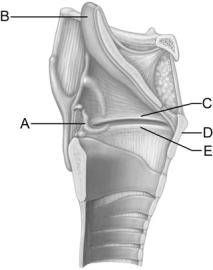A) carina
B) alveoli
C) respiratory membrane
D) bronchopulmonary segments
E) terminal bronchioles
Correct Answer

verified
Correct Answer
verified
Multiple Choice
Some bronchi have names such as the ʺright upper-lobe bronchus,ʺ ʺleft lower-lobe bronchus,ʺ and ʺright middle-lobe bronchus.ʺ These are bronchi.
A) primary
B) secondary
C) tertiary
D) very small (about fifteenth-order)
Correct Answer

verified
Correct Answer
verified
True/False
Changes in the size of the thoracic cavity bring about inspiration and expiration.
Correct Answer

verified
Correct Answer
verified
Short Answer
The tonsil, or adenoids, is located on the wall of the nasopharynx.
Correct Answer

verified
Correct Answer
verified
Multiple Choice
 Figure 22.2
Use the diagram above to answer the following questions.
-Identify the letter that indicates the soft wall of the trachea allows the esophagus to expand anteriorly.
Figure 22.2
Use the diagram above to answer the following questions.
-Identify the letter that indicates the soft wall of the trachea allows the esophagus to expand anteriorly.
A) A
B) B
C) C
D) D
E) E
Correct Answer

verified
Correct Answer
verified
Multiple Choice
Supportive cartilage disappears from the bronchial tree at the level of the
A) alveolar duct.
B) respiratory bronchiole.
C) bronchioles.
D) lobar bronchi.
Correct Answer

verified
Correct Answer
verified
Multiple Choice
The ability to vary the pitch of the voice results from varying
A) the tension in the vocal folds.
B) the size of the laryngeal cartilages.
C) the shape of the cricoid cartilage.
D) the force of air passing over the vocal folds.
Correct Answer

verified
Correct Answer
verified
Multiple Choice
Of the three different layers of tissue in the wall of the trachea, the outermost layer is the
A) submucosa.
B) adventitia.
C) muscularis.
D) lamina propria.
Correct Answer

verified
Correct Answer
verified
Multiple Choice
What type of epithelium occurs in the respiratory mucosa?
A) pseudostratified ciliated columnar epithelium
B) stratified squamous epithelium
C) simple columnar epithelium
D) simple squamous epithelium
Correct Answer

verified
Correct Answer
verified
Multiple Choice
The space between the right and left vocal folds is called the
A) vestibule.
B) laryngeal inlet.
C) rima glottidis.
D) cricoid.
Correct Answer

verified
Correct Answer
verified
Multiple Choice
In a runner who is breathing heavily during a race, the rima glottidis is
A) all the way closed.
B) half closed.
C) half open.
D) open as far as possible.
Correct Answer

verified
Correct Answer
verified
Multiple Choice
The lobes of a lung are easy to recognize and distinguish from one another because
A) they are separated by fissures.
B) carbon from the air accumulates between and outlines the lobes in most people (even if they breathe almost-unpolluted air) .
C) they all have slightly different colors.
D) each is supplied by a primary bronchus, and the primary bronchi are easy to find.
Correct Answer

verified
Correct Answer
verified
Multiple Choice
The part of the brain that generates the basic respiratory rhythm is the
A) cerebrum.
B) hypothalamus.
C) limbic system.
D) medulla oblongata.
Correct Answer

verified
Correct Answer
verified
Multiple Choice
Most foreign substances in inspired air fail to reach the lungs because of the
A) porous structure of the nasal conchae.
B) ciliated epithelium and mucus that line the respiratory passages.
C) abundant blood supply to the nasal mucosa.
D) action of the epiglottis.
Correct Answer

verified
Correct Answer
verified
Multiple Choice
 Figure 22.3
Use the diagram above to answer the following questions.
-Identify the letter that indicates the cartilage that folds over the opening of the larynxthe glottis. The function of this cartilage is to prevent aspiration of foods and liquids into the lower respiratory tubes.
Figure 22.3
Use the diagram above to answer the following questions.
-Identify the letter that indicates the cartilage that folds over the opening of the larynxthe glottis. The function of this cartilage is to prevent aspiration of foods and liquids into the lower respiratory tubes.
A) A
B) B
C) C
D) D
E) E
Correct Answer

verified
Correct Answer
verified
Multiple Choice
A chronic respiratory disease that leads to an expanded ʺbarrel chestʺ is
A) lung cancer.
B) pneumonia.
C) emphysema.
D) tuberculosis.
Correct Answer

verified
Correct Answer
verified
Multiple Choice
Which structure is both a lower respiratory structure and in the conducting zone? (Hint: Recall Figure 22.3.)
A) an alveolus
B) the laryngopharynx
C) a respiratory bronchiole
D) any bronchus
Correct Answer

verified
Correct Answer
verified
Multiple Choice
Embryologically, the nasal cavity develops from
A) the early precursor of the paranasal sinuses.
B) a cranial extension of the mouth.
C) invagination of the ectoderm of the olfactory placode.
D) the nasopharynx.
Correct Answer

verified
Correct Answer
verified
Multiple Choice
In the wall of the trachea and bronchi, the cartilage rings lie within which tissue layer?
A) fibromusculocartilaginous layer
B) inner epithelium
C) submucosa
D) mucosa
Correct Answer

verified
Correct Answer
verified
Multiple Choice
The superior and middle nasal conchae are bony projections from the
A) maxillary bone.
B) sphenoid bone.
C) vomer.
D) ethmoid bone.
Correct Answer

verified
Correct Answer
verified
Showing 21 - 40 of 110
Related Exams